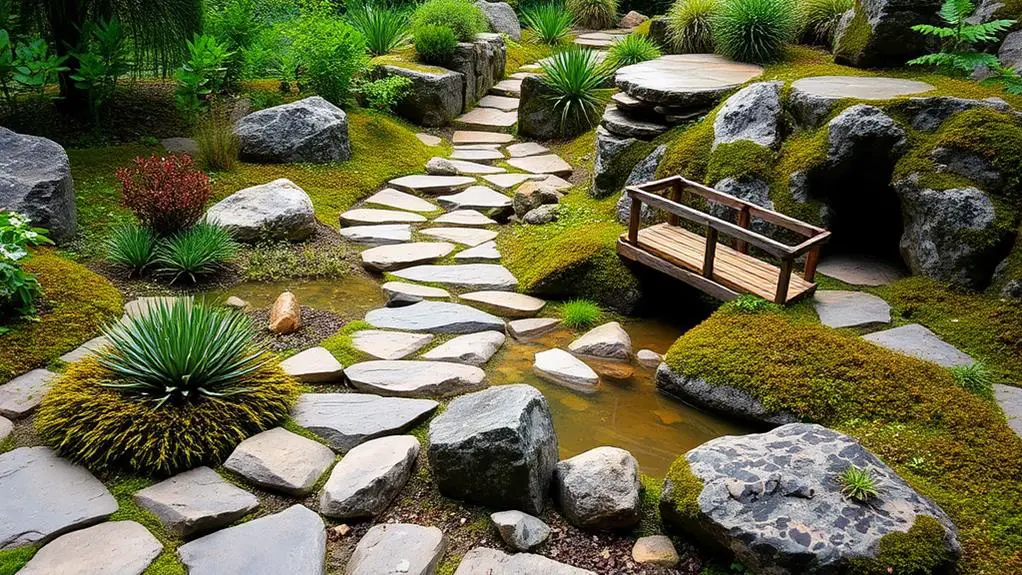As you step into your own backyard, you crave a serene escape from the chaos of daily life. A low-maintenance Japanese Zen garden can be your haven, where carefully chosen elements work together to create a tranquil atmosphere. By incorporating natural stone, moss, and water features, you'll set the tone for relaxation. But what specific design principles and plant choices will help you achieve this peaceful oasis without breaking a sweat?
Essential Elements of Zen Design
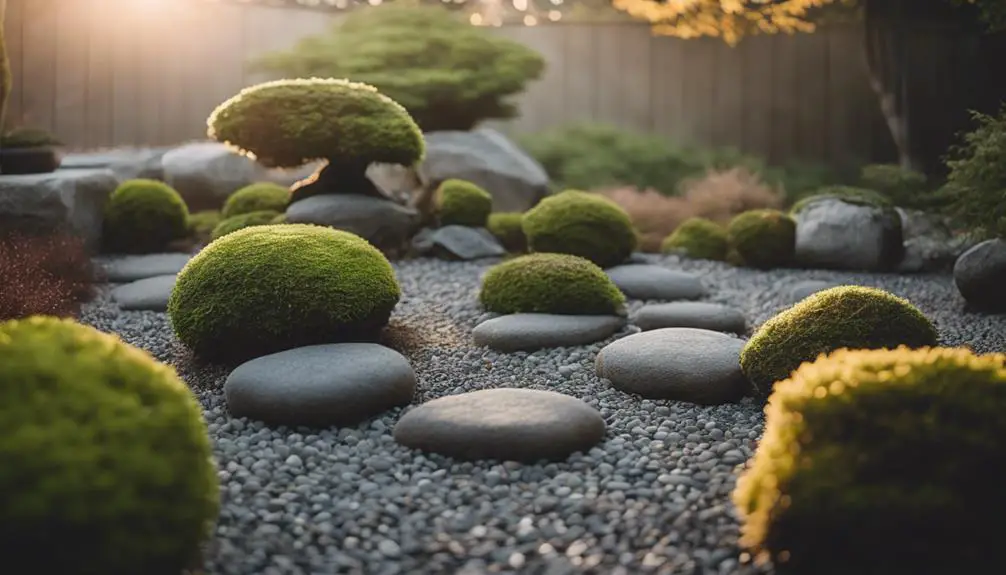
You'll typically find six essential elements in a traditional Japanese Zen garden design: natural stone, water, moss, wood, bamboo, and plants, each carefully selected to evoke a sense of serenity and connection to nature.
These elements work in harmony to create a visually stunning space that embodies Zen principles.
Natural stone, often used for pathways and ornaments, adds a sense of permanence and solidity.
Water features, such as ponds or fountains, introduce the soothing sound of running water, creating a calming atmosphere.
Moss, with its lush green hue, brings a sense of softness and tranquility.
Wood and bamboo, used for fences, gates, and ornaments, add warmth and texture.
Plants, carefully chosen for their simplicity and elegance, complete the design.
The careful balance of these elements is vital in achieving design harmony, a fundamental aspect of Zen principles.
Choosing Low Maintenance Plants
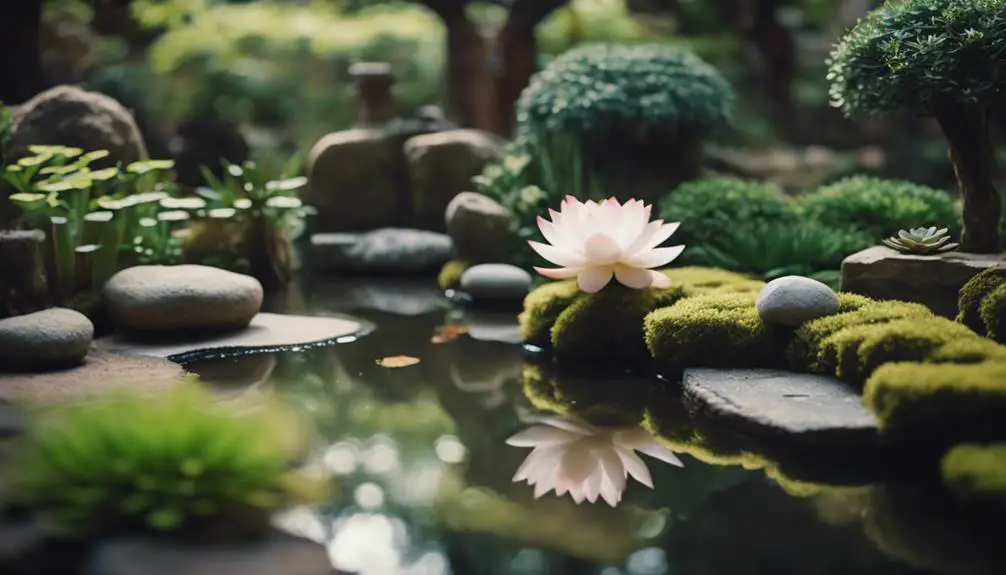
When selecting plants for your Japanese Zen garden, opt for low-maintenance species that thrive in shade and require minimal pruning, such as slow-growing groundcovers like thyme or creeping juniper. These plants will complement your garden's serene ambiance while reducing upkeep.
You'll also want to incorporate drought-tolerant plants, like sedum or succulents, which can survive with infrequent watering. This is especially important in areas with water restrictions or during hot summer months.
Shade-loving plants, such as ferns or hostas, will add lush texture and color to your garden.
Look for varieties with interesting foliage patterns or unique growth habits to create visual interest.
Consider using mosses or lichens to fill in gaps between pavers or stones, as they require minimal care and can thrive in low-light conditions.
Incorporating Natural Stone Features
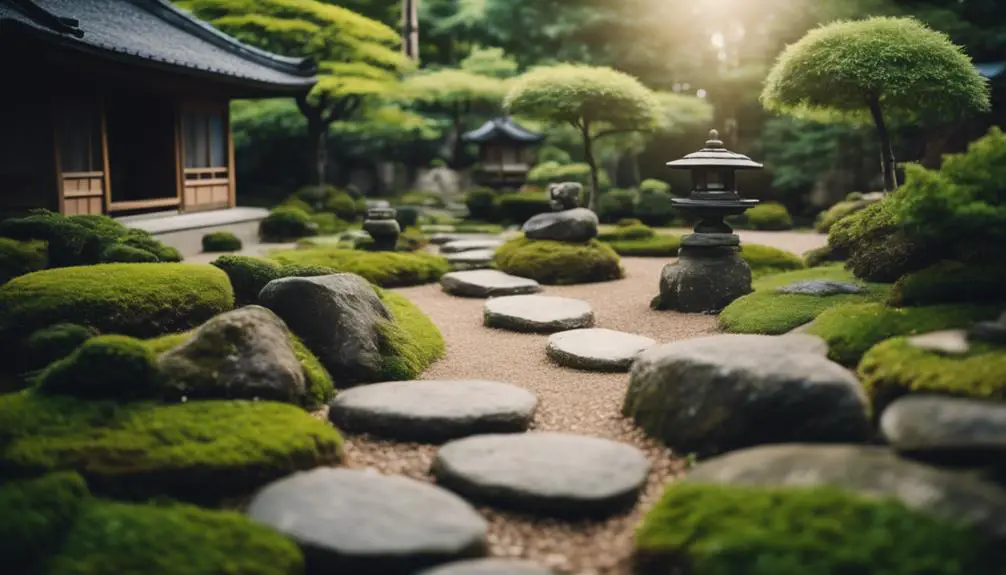
As you design your Japanese Zen backyard garden, you'll want to incorporate natural stone features that create a sense of harmony and balance.
You can start by envisioning a stone patio that flows seamlessly into the surrounding landscape, or by selecting natural rock accents that complement your chosen plant species.
Stone Patio Design Ideas
Incorporating natural stone features into your Japanese Zen backyard garden's patio design creates a serene, organic ambiance that harmonizes with the surrounding landscape.
When selecting a patio shape, consider irregular forms that mimic nature, such as a meandering path or a curved seating area. This will create a sense of fluidity and visual interest.
To add texture and depth, incorporate stone borders that complement the patio's shape. For instance, use rectangular stone borders to frame a circular patio or irregular stone borders to accentuate a free-form patio.
You can also alternate between different stone sizes, colors, or textures to create a visually appealing pattern. Additionally, consider incorporating built-in seating areas, such as benches or ledges, to create a cozy nook for relaxation.
Natural Rock Accents
You can strategically place natural rock accents throughout your Japanese Zen backyard garden to create visual focal points that draw the eye and evoke a sense of serenity.
By incorporating natural stone features, you'll add depth and character to your outdoor space. Consider using rock formations to create a dramatic entrance or to define different areas within your garden.
Boulders placement can also be used to create a sense of balance and harmony. For example, you can place a large boulder near a water feature, such as a koi pond or fountain, to create a visually appealing contrast.
Alternatively, you can use smaller rocks and pebbles to create a serene and peaceful atmosphere. When choosing natural rock accents, consider the color, texture, and shape of the stones to verify they complement your garden's overall aesthetic.
Water Elements for Serenity
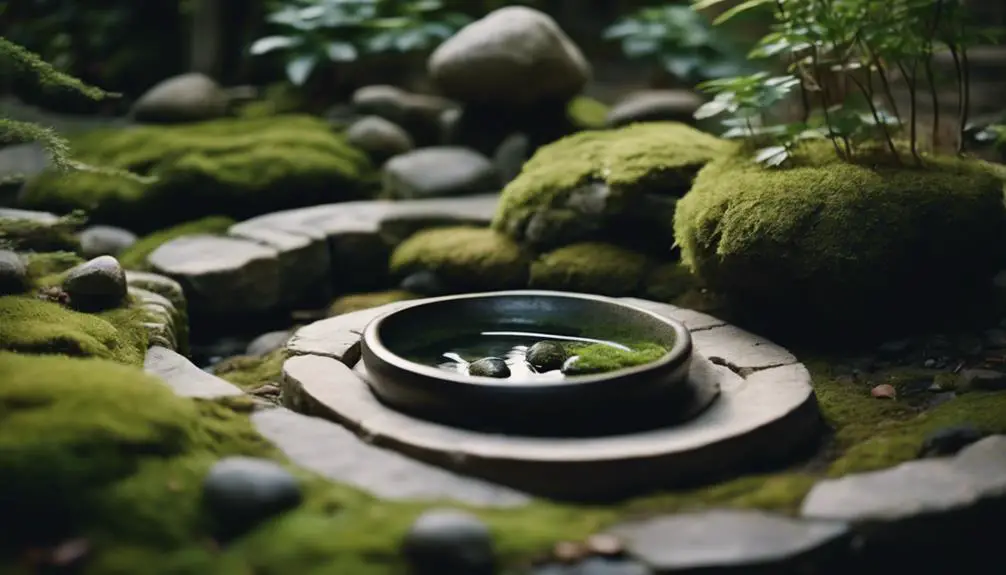
As you design your Japanese Zen backyard garden, you'll want to incorporate water elements that evoke a sense of serenity.
You can achieve this by incorporating calm water features, such as a koi pond or a small reflecting pool, which create gentle ripples that catch the light.
Ripples of Calm Water
Three shallow pools of water, strategically placed throughout your Japanese Zen backyard garden, create a soothing melody of gentle ripples that calm the mind.
As you walk through your serene outdoor space, the subtle movement of the water's surface catches your eye, drawing you in with its mesmerizing tranquility. The gentle lapping of the water against the pool's edges creates a sense of continuity, linking each pool to the next, and visually connecting the entire garden.
The stillness of the water's surface serves as an aquatic mirror, reflecting the surrounding landscape and adding depth to the garden's visual plane.
The reflected images of trees, flowers, and sky create an optical illusion, making the garden appear larger and more expansive. The water reflections also introduce an element of symmetry, balancing the garden's composition and creating a sense of harmony.
Soothing Sound Effects
Water elements, such as gentle cascades, soft trickles, and calming drips, weave a sonic tapestry that envelops your Japanese Zen backyard garden, transporting you to a domain of serenity.
As you step into your outdoor oasis, the soothing sound effects of water elements calm your mind and quiet your senses. Whispering fountains, for instance, create a subtle yet mesmerizing melody that resonates deep within you.
The gentle lapping of water against the fountain's edges generates a soothing rhythm, blocking out distracting noise and calming your nervous system. The sound waves produced by these water features have a profound impact on your psyche, reducing stress and anxiety while promoting relaxation and tranquility.
Simple Yet Effective Lighting

You can achieve a serene ambiance in your Japanese Zen backyard garden by strategically placing lanterns and spotlights to accentuate key features, creating pools of light that guide the eye through the space.
To create a Moonlight Ambiance, position lanterns with soft, warm glows near water features, like ponds or fountains, to mimic the gentle illumination of a full moon. This will create a sense of tranquility and calm.
For a more subtle approach, incorporate Solar Lanterns along pathways or near seating areas. These eco-friendly lanterns harness the sun's energy during the day and emit a soft, ambient light at night, adding depth and visual interest to your garden.
By thoughtfully placing lighting fixtures, you can draw attention to specific design elements, such as sculptures or plants, and create a sense of flow throughout the space.
As the sun sets, your Japanese Zen backyard garden will transform into a peaceful oasis, perfect for relaxation and contemplation.
Minimalist Pathway Options
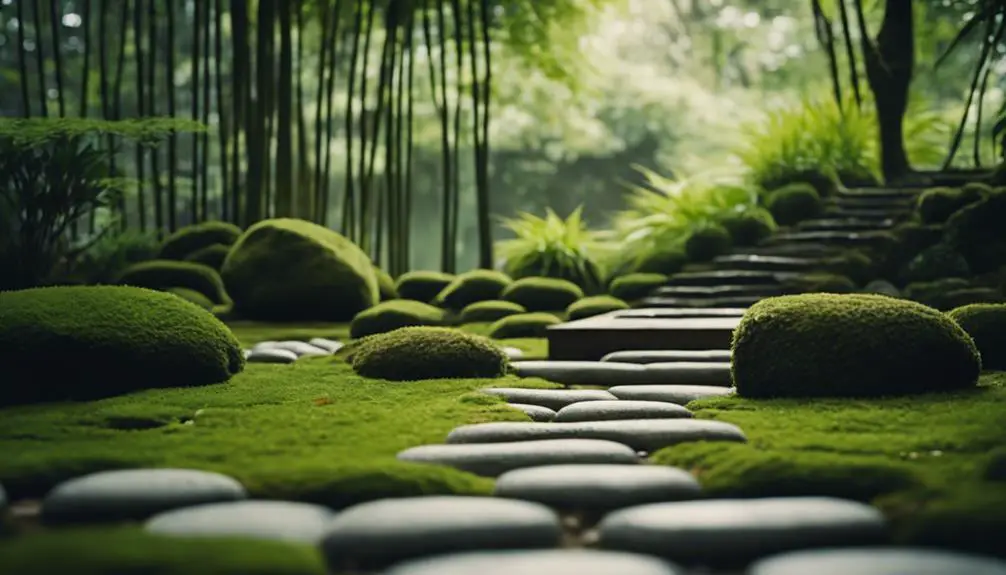
As lanterns fade into the background, your attention turns to the subtle yet impactful role of pathways in guiding visitors through your Japanese Zen backyard garden.
You'll want to choose pathway materials that complement your garden's serene ambiance while requiring minimal upkeep.
Gravel, a traditional choice, can be noisy and difficult to maintain. Consider gravel alternatives like decomposed granite or pea gravel, which provide a similar aesthetic without the hassle.
For a more modern take, explore pathway materials like porcelain pavers or concrete stepping stones. These options offer a clean, minimalist look and are easy to clean.
You can also incorporate natural stone, like bluestone or fieldstone, to add texture and visual interest.
Regardless of the material you choose, guarantee it's durable and slip-resistant to create a safe and inviting walkway.
Selecting Focal Point Features
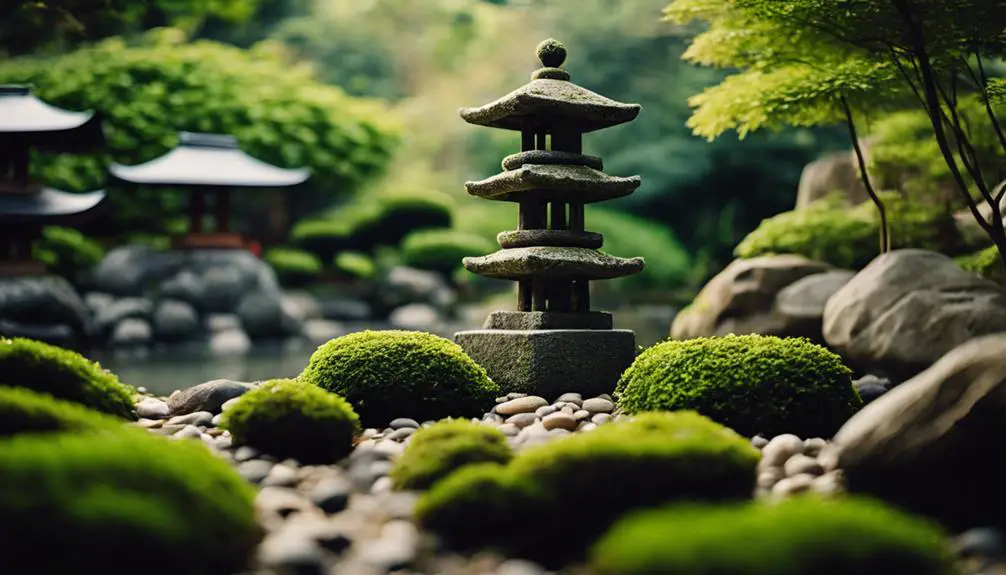
As you design your Japanese Zen backyard garden, you'll want to carefully select focal point features that create visual anchor points, drawing the eye to specific areas of the space.
You'll need to balance these features to achieve harmony, considering elements like scale, texture, and color.
Key Design Elements
Carefully selecting focal point features is crucial in a Japanese Zen backyard garden, since these elements draw the eye and create visual harmony, guiding the viewer's attention through the space.
You'll want to choose features that embody Zen principles, such as simplicity, naturalness, and subtlety. Garden ornaments like stone lanterns, Buddha statues, or bonsai trees can serve as focal points, adding visual interest and creating a sense of calm.
Consider the scale and proportion of each feature in relation to the surrounding space, ensuring they don't overwhelm the senses. Balance is key in a Zen garden, so distributing focal points thoughtfully throughout the space is imperative.
Visual Anchor Points
You'll typically choose one or two visual anchor points to serve as the primary focal point features in your Japanese Zen backyard garden, strategically placing them to draw the eye and create a sense of balance.
These visual anchors will guide the viewer's attention, creating a sense of harmony and visual flow.
Focal anchors, such as a statement stone or a majestic tree, serve as the main attractions, drawing the eye to specific areas of the garden.
When selecting visual anchor points, consider the shape, size, texture, and color of the feature.
A large, rust-colored boulder, for instance, can create a striking visual anchor, while a delicate, moss-covered stone lantern can add a touch of serenity.
You can also use water features, such as a small pond or fountain, to create a soothing visual anchor.
Remember, the goal is to create a sense of balance and harmony, so choose features that complement each other and the overall aesthetic of your garden.
Focal Point Balance
Two to three focal point features are typically necessary to achieve balance in a Japanese Zen backyard garden, each one carefully chosen to create visual harmony and draw the eye to specific areas of the landscape.
You'll want to select features that align with the balance principles of Japanese design, which emphasize simplicity, asymmetry, and naturalness. Consider incorporating a statement stone, a sculptural tree, or a decorative lantern as your primary focal point.
Then, balance it with one or two secondary features, such as a small water feature or a carefully placed boulder. Remember, the goal is to create visual harmony, not visual competition.
By thoughtfully selecting and placing your focal point features, you'll create a sense of calm and serenity in your garden. As you walk through your space, your eyes should be drawn to each feature in a natural, organic way, creating a sense of flow and balance.
Balanced Composition Techniques
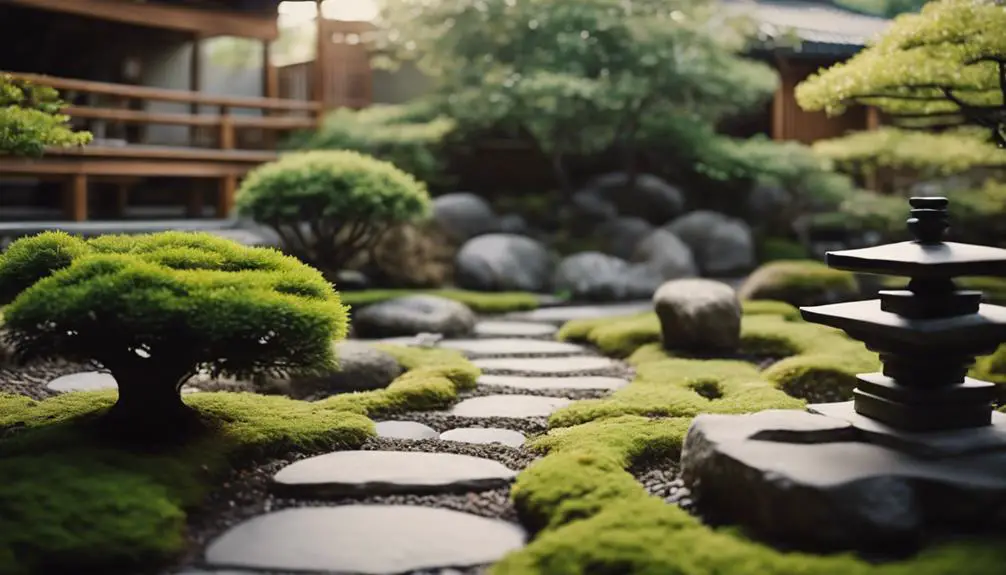
In a Japanese Zen backyard garden, balance is achieved by strategically placing elements to create visual harmony, ensuring that no single feature dominates the senses.
As you design your garden, consider the principles of balance and harmony to create a sense of calm and serenity.
To achieve visual harmony, you'll want to strike a balance between formal and informal elements, such as structured hedges and naturalistic plantings.
You can also create balance by juxtaposing different textures, like smooth stone and rough wood.
But balance isn't just about symmetry; it's also about creating spatial tension.
By placing elements in a way that creates a sense of tension, you can add visual interest to your garden.
For example, you might place a large stone near a small plant, or position a curved path near a straight hedge.
This tension creates a sense of dynamic energy, drawing the eye through the garden.
By balancing these elements, you'll create a harmonious and engaging space that invites contemplation and relaxation.
As you design your garden, remember to balance formal and informal elements, and strategically create spatial tension to achieve a truly Zen atmosphere.
Calming Color Schemes Explained

As you select colors for your Japanese Zen backyard garden, choose a palette that soothes the senses, featuring calming hues like mossy green, weathered wood, and soft gray that evoke feelings of serenity and tranquility.
These natural shades create a sense of color harmony, allowing your garden to blend seamlessly with its surroundings.
Nature-inspired colors like these will help you achieve a peaceful ambiance, perfect for a Zen garden.
To enhance the calming effect, consider using a monochromatic color scheme, where different shades of a single color are used.
This will create a sense of continuity and visual flow, drawing your eye through the garden.
For added depth, incorporate neutral colors like beige or cream to provide contrast and balance.
Remember, the key to a calming color scheme is simplicity and restraint.
Avoid bold or bright colors, which can be jarring and disrupt the peaceful atmosphere you're trying to create.
Easy to Care for Ground Covers

You'll want to ponder low-maintenance ground covers like creeping thyme, dwarf mondo grass, or sweet woodruff to fill gaps between pavers, stones, or other hardscapes in your Japanese Zen backyard garden.
These ground covers are perfect for areas with high foot traffic or where you want to create a seamless shift between different design elements.
Creeping thyme, for instance, can thrive in zones with moderate to high sunlight and requires minimal watering and pruning. Its tiny leaves and stems will spread quickly, filling in gaps and creating a lush, vibrant carpet.
Dwarf mondo grass, on the other hand, is a low-growing, clumping grass that's ideal for areas with partial shade. It's drought-tolerant and requires minimal maintenance, making it perfect for busy homeowners.
Sweet woodruff, with its delicate white flowers and sweet fragrance, is another great option for shady areas. It's relatively low-maintenance and can be walked on without damaging the plants.
Adding Decorative Accents Wisely
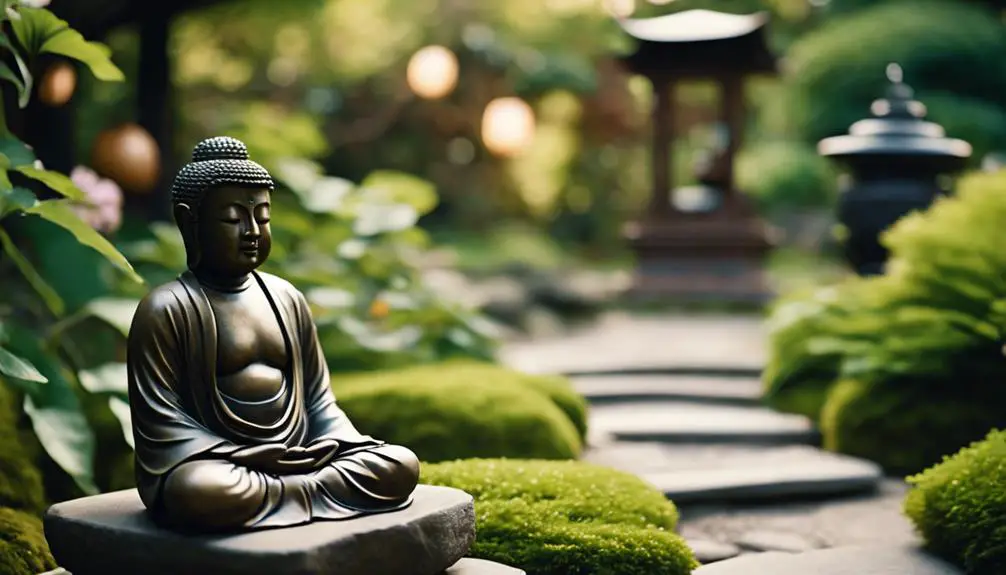
Carefully select a few decorative accents that thoughtfully complement your Japanese Zen backyard garden's serene atmosphere, such as a weathered stone lantern, a delicate bamboo fountain, or a subtle metal wind chime.
These accents should enhance the garden's tranquil ambiance without drawing attention away from its natural beauty. Practice decorative minimalism by limiting the number of accents to avoid visual clutter.
When it comes to accent placement, consider the garden's flow and visual balance. Place accents strategically to create visual interest and guide the viewer's eye through the space.
For instance, position a lantern near a seating area to create a sense of warmth and invitation. Alternatively, place a wind chime near a water feature to create a soothing harmony of sounds.
Space Saving Design Ideas
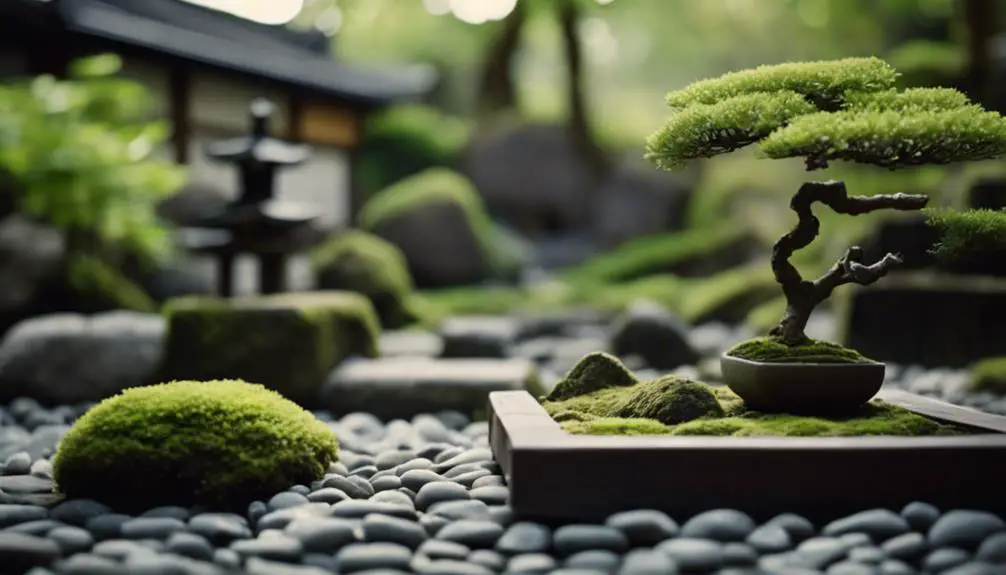
In compact Japanese Zen backyard gardens, every square foot counts, so consider incorporating space-saving design elements, like vertical planters or tiered water features, to maximize functionality without sacrificing aesthetics.
You'll be amazed at how these clever solutions can transform small plots into serene oases.
Vertical gardens, for instance, can be attached to walls or fences, providing ample greenery without encroaching on precious floor space.
This approach also allows for better air circulation and sunlight penetration, promoting healthy plant growth.
To further optimize your space, consider multi-tiered planters or shelves that can be used to display decorative items, like bonsai trees or stone lanterns.
By going vertical, you'll create the illusion of more space while keeping the overall design clean and uncluttered.
Additionally, incorporate narrow, winding pathways that encourage slow and contemplative strolls, allowing you to fully appreciate the beauty of your compact Zen garden.
Creating a Sense of Seclusion

By strategically positioning screens, fences, or trellises, you can effectively block out neighboring views and distractions, enveloping your compact Japanese Zen backyard garden in a sense of seclusion and tranquility.
This thoughtful design approach enables you to create a private oasis, detached from the outside world, where you can unwind and recharge.
To achieve this secluded escape, consider incorporating natural screens like bamboo or reeds, which can be planted along boundaries or used as freestanding features.
Alternatively, wooden or metal trellises can be installed to support climbing plants, such as ivy or wisteria, which will gradually conceal adjacent buildings or fences.
For a more dramatic effect, you can opt for solid fences or screens made from materials like wood, metal, or stone, carefully selecting a design that complements your garden's aesthetic.
Frequently Asked Questions
How Do I Prevent Weeds From Growing in My Zen Garden?
To prevent weeds from growing, you'll want to install a weed barrier, ensuring a tight seal around plants, then layer a 2-3 inch thick mulch to block sunlight and suppress weed growth, while maintaining a clean, minimalist aesthetic.
Can I Use a Zen Garden for Outdoor Yoga or Meditation?
You can transform any outdoor space into a serene oasis for mindful movements, leveraging natural ambiance to enhance your yoga or meditation practice, and a zen garden is an ideal setting to cultivate inner peace.
Are Japanese Zen Gardens Suitable for Small Backyards?
You can create an intimate urban oasis in even the smallest backyards, transforming them into a cozy retreat. Japanese Zen gardens, with their minimalist aesthetic, are particularly well-suited for compact spaces, allowing you to craft a serene atmosphere.
Can I Incorporate a Fire Pit Into My Zen Garden Design?
You can strategically place a fire pit to elevate your outdoor space, creating an inviting evening ambiance. Position it centrally, surrounded by seating, or nestle it into a cozy nook, ensuring a harmonious blend of warmth and serenity.
How Often Should I Clean My Zen Garden's Water Features?
You'll want to clean your water features regularly to prevent algae buildup, which can compromise their aesthetic appeal. Aim to skim debris daily, and perform a deep clean every 1-2 weeks to maintain ideal algae prevention and feature aesthetics.
Conclusion
As you step into your low-maintenance Japanese Zen backyard garden, the harmonious balance of natural stone, moss, and water features envelops you in serenity.
With carefully selected plants, simple lighting, and easy-to-care-for ground covers, your oasis is complete.
By incorporating essential Zen design elements, you've created a space perfect for contemplation and relaxation.
Now, sit back, breathe deeply, and let the tranquility of your Japanese Zen garden wash over you.



